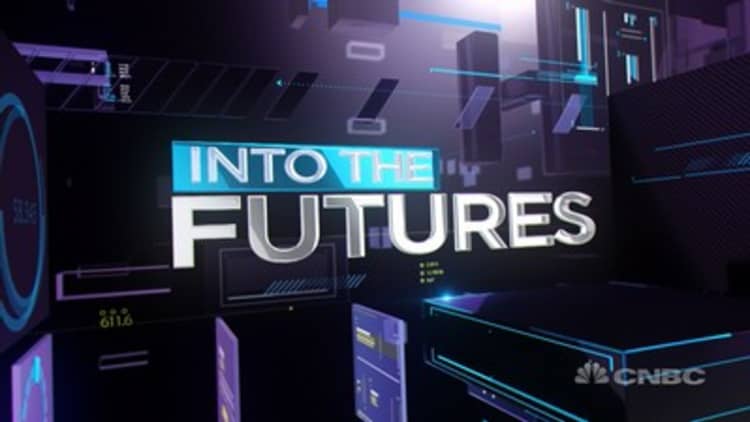
It is often said that hope is not an investment strategy. Yet that chestnut may not apply to central bankers, because hope appears to be the Federal Reserve's strategy of choice when it comes to inflation.
In a Thursday speech delivered at the University of Massachusetts Amherst, Fed chair Janet Yellen predicted that at long last, inflation is set to hit the Fed's long-run 2 percent inflation target in the years ahead.
Though inflation has been running at "essentially zero" over the past year, "the Committee expects that inflation will gradually return to 2 percent over the next two or three years," Yellen said.
Read MoreJohn Boehner just made Janet Yellen's life harder
Furnishing the below chart, she reasoned that much of the inflation "shortfall" is likely due to low energy and non-energy prices—both of which can be pinned on sliding oil and the surging U.S. dollar.
Let's wait a while
A plausible conclusion, then, is "that the current near-zero rate of inflation can mostly be attributed to the temporary effects of falling prices for energy and non-energy imports," Yellen stated.
"If so, the 12-month change in total PCE prices [referring to the Fed's preferred measure of inflation] is likely to rebound to 1.5 percent or higher in 2016, barring a further substantial drop in crude oil prices and provided that the dollar does not appreciate further," she added.
Yellen's thesis that inflation is set to rise back to 2 percent is also predicated on the view that "prospects for the U.S. economy generally appear solid."
Landing the plane, the Fed chair made the case for a rate hike in 2015, reasoning that moving before inflation actually hits 2 percent will obviate the need for a series swift rate hikes.
However, if the Fed intends to make policy based on its models of what the future will look like rather than on actual data, it has a bit of a problem: Its own (questionable) track record.
Over the past few years, the Fed's own economic growth forecasts have consistently proven too bullish. For instance, three years ago, the Fed expected to see real gross domestic product (GDP) growth of 3.0 to 3.8 percent this year; currently, just 2.1 percent growth is expected. Needless to say, inflation forecasts have also run too hot: back in 2012, inflation of 1.8 to 2.0 percent was anticipated for 2015.
The concern is that if the Fed is looking to similarly bullish models for its inspiration to raise rates, the central bank could be led to move too quickly.
"You do have to use models to project where things are going, because policy has to be forward-looking, and then if they're wrong on the activity front then they'll start to make adjustments," said Robert Murphy, associate professor of economics at Boston College.
That said, "my view is that you could wait a little bit longer to be more certain," especially given the low level of wage increases.
While Murphy agrees that monetary policies works with a substantial lag, "I'm not worried about reaching that 2 percent inflation and then having it suddenly take off. Inflation tends to be a persistent data series, and it won't suddenly jump from 1.5 to 4 to 8," particularly in the current environment.
Read More Could negative rates be next on the Fed's policy menu?
Haverford economist Carola Binder, who has done substantial work on inflation expectations, similarly expressed that "I hope we will see much stronger evidence of both price and wage growth before monetary policy tightening begins."
Binder wrote to CNBC.com from a conference on household economic decision-making at the Cleveland Fed.
She pointed out that households "are very uncertain about inflation and probably unaware of the Fed's target," so even if inflation does briefly exceed the Fed's target, she doesn't think that will foster "a big rise in inflation expectation."
Don't hold your breath, economist says
On Wall Street, not even Deutsche Bank economist Joseph LaVorgna—long known for his bullish views on US growth—believes that growth will be sufficient to deliver plus-2-percent inflation.
"It's true that transitory factors are weighing in inflation" but "inflation won't hit the Fed's target "anytime soon," LaVorgna told CNBC.
Markets similarly expect sub-2-percent inflation, as a glance at "breakeven" rates (which compare the yield on Treasuries to the yield on Treasury inflation-protected securities) makes clear. This popular metric shows that over the next five years, an inflation rate of just 1.1 percent is expected. Meanwhile, the 10-year expectation is for inflation of 1.5 percent. Since mid-2011, both of these numbers have fallen steadily lower.
The upshot, then, is that few outside of the Fed see reason to expect inflation will rise to the central bank's target in the next year—much less far above it.
With markets waiting with baited breath on the Fed's next move, the extent to which Yellen backs down from her model-driven view on inflation remains a key question for investors.
—By CNBC's Alex Rosenberg.
Watch "Futures Now" Tuesdays & Thursdays 1 p.m. ET exclusively on FuturesNow.CNBC.com!



